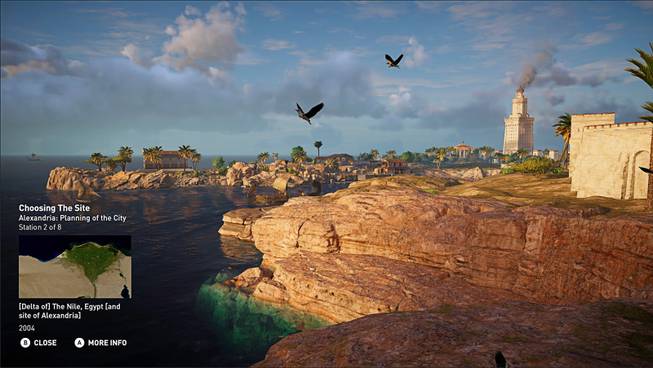
Ubisoft via The New York Times
In an image provided by the game developer Ubisoft, a view of ancient Alexandria as seen in the Discovery Tour mode of Assassin’s Creed Origins. With an eye to serving as a classroom aid, the latest iteration of the Assassin’s Creed game series has a mode that trades conspiracy-tinged quests and violence for lessons on antiquities, history and daily life in ancient Egypt.
Sunday, May 20, 2018 | 2 a.m.
History has long served as a backdrop in the Assassin’s Creed video games, whose storylines center on pivotal times in history — from the Third Crusade to Imperial China and beyond. But when players of this Ubisoft series rush from mission to mission, as agents of events both great and small, their purpose is rarely to take the time to appreciate history itself. Duty always calls.
Until now.
Following last year’s release of “Assassin’s Creed Origins,” set in Ptolemaic Egypt, the team behind it decided that allowing players to learn more about life in ancient Egypt might make for a pretty cool teaching aid. So they traded in the quests and violence for antiquities and history lessons, and created a mode with a series of Discovery Tours. By putting history front and center, the game may give teachers a new way to connect with some students.
Edyeli Marku, a middle-school teacher at Intermediate School 230 in Queens, New York, said there could be “tremendous value in it,” for both students and educators — particularly for students who might test as primarily visual, auditory or kinesthetic learners. For those students, she added, “exposing them to a different learning vehicle is always beneficial.”
Marku said she understands the importance of games to her students and has used Oregon Trail as a teaching tool.
“They go on the phone like it’s nothing,” she said. “They go on an iPad, and they can spend hours in front of it.”
Maxime Durand, who has been the lead researcher and history consultant for the Assassin’s Creed franchise since 2010, and Jean Guesdon, the creative director on “Origins,” said they had often heard from educators who saw the potential of using the games. Some had even used small portions in their lessons. But so much of Assassin’s Creed, given its violence and fictional narrative, is problematic in a school setting.
Even Marku said the violent content could hamper the franchise’s acceptance for education purposes, especially for parents reacting to the name of the series or those familiar with its subject matter.
In this version of the game, though, players guide their chosen avatar. It can be the sheriff-like character Bayek, the original protagonist of “Assassin’s Creed Origins,” or one of 25 possible others including Bayek’s wife, Aya; their son, Khemu; Cleopatra; Julius Caesar; Roman legionnaires; and even ordinary Egyptian, Greek and Roman adults and children.
A voice-over details the objects on view, including artifacts like pottery, scrolls, farm tools and baking ovens. The 75 available tours cover daily life, monuments, agriculture, the lives of Greek and Roman settlers, and other topics. At some locations, non-playable characters are seen performing tasks like baking bread, tilling a field or inscribing scrolls. Here players can elect to have their chosen avatar perform the activity. Maybe Cleopatra and Caesar never knelt before a bread oven to remove a hot loaf from the coals, but here players can have that experience.
The Library of Alexandria is another stop. In recreating it, Durand said, his team looked to the remnants of the Library of Celsus, which is still standing amid the ancient ruins in Ephesus, Turkey.
Of course, a lot of history’s secrets are lost to time. That’s where a Behind the Scenes feature comes in. The makers use it to explain how and why they chose to represent certain objects. Durand said he hoped this would also prompt students to think critically about how games are created and the way stories are told.
Marc-André Éthier, a professor at the University of Montreal who studies materials that are being used to teach high school history, noticed that traditional tools like textbooks were being used less. When he heard about the Discovery Tour, he said, “I was intrigued, and I prepared a study to test if Discovery Tour could teach someone as much as a lecture.”
Éthier said he approached Ubisoft with an idea for what eventually became a study of some 330 students, 12 to 16 years old, in nine schools in Montreal. Students were divided into groups of 40. First, all the students were given a test. Then half of each group took the Library of Alexandria tour, and the other had a lesson with a teacher. Afterward, they took a second quiz. Éthier said the students working with a teacher did better on the test than the ones who had only taken the tour. But the test scores of the students who took the tour still showed improvement, of 22 percent to 44 percent.
To make the games accessible to a broader range of schools, which typically have computers or tablets rather than game consoles, Ubisoft released a stand-alone version ofthe Discovery Tour for computers, even those with aging hardware.
Evelyne Ferron, who specializes in Egyptian history and worked on the project, said she wanted players to “realize the colors of Egypt.” Today the Sphinx, the pyramids and temples are bleached white, but they were once vividly colored. Players can see the gold and blue of the sphinx, and the rich browns, blues and greens of the hieroglyphics and murals on the temple walls.
Still, she said, full realism is not always possible and is sometimes less important when entertainment is the goal. “When you create a game,” Ferron said, “you need to create immersion.” A historian taking a strict view of history would not sacrifice realism, she said. “Sometimes you have to trick history.”
